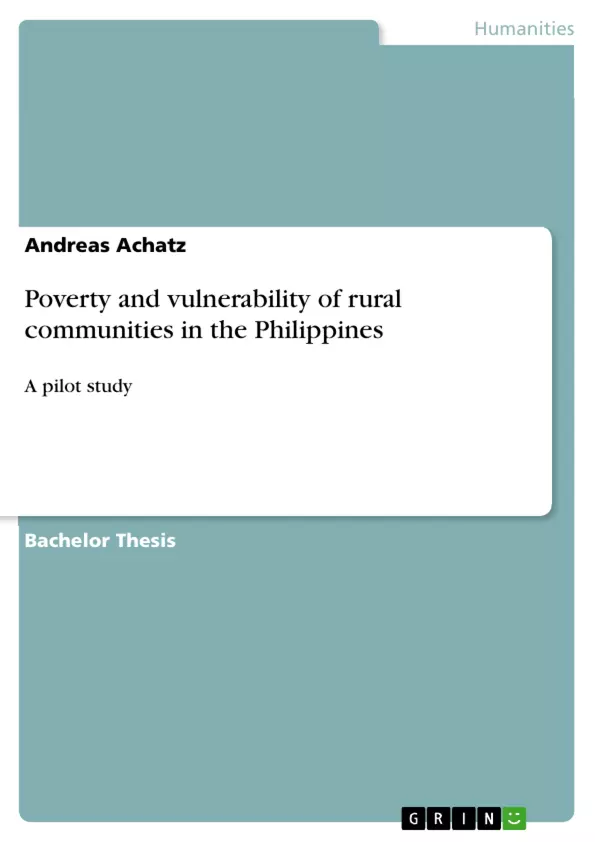This paper outlines different categories of vulnerabilities for poverty and their intertwining dependencies. Risks and vulnerabilities limit the activities and opportunities that can be undertaken to reduce poverty. Beside adverse events such as climate change, typhoons, floods and droughts, the livelihood can be seen as the primary source of vulnerability. In consequence a process of environmental degradation, a lack of opportunities and a lack of agricultural inputs is arising out of ignored vulnerabilities.
Through a standardized questionnaire a broad range of underlying factors, processes and different constructions of vulnerabilities are compared and analyzed. 247 rural Philippine households in twelve different communities contributed to the survey. The comparison of different factors (health, economy agriculture, environment, education and community integration) highlights a set of indicators to measure vulnerabilities for poverty. Moreover, core dependencies and their intertwining sub-dependencies have been emphasized.
Triangulation completes the picture of poverty and its vicious circle. A qualitative research through focus group discussions has drawn an overview of the community health needs. Furthermore the results have been underpinned by literature research. The output of the study results in indicators of vulnerabilities to poverty. These indicators allow the objective measurement of poverty and consequently the increase of local capacities on a cross sectoral basis. Addressing risks, vulnerabilities and poverty on current data is essential to meet the needs of the communities and to achieve sustainability.
Table of Contents
- Introduction
- Vulnerability
- Poverty
- The Philippines
- Aklan and its communities
- The household approach
- The Projects
- Peoples Initiative Network of Aklan (PINA)
- Medical Mission Group (MMG)
- Research Question
- Methodology
- Qualitative Research
- Identification of Community Health Needs through Focus Group Discussions
- Results and analysis
- The Barangays - the villages
- The households - the sample
- Indicators of Vulnerability for poverty in rural communities in the Philippines
- Indicators
- Core dependencies
- Sub-dependencies: Health
- Sub-dependencies: Agricultural Situation
- Sub-dependencies: Economical situation
- Sub-dependencies: Environmental Situation
- Sub-dependencies: Community integration
- Sub-dependencies: Education
- Limitations and summary
- Limitations
- Outlook
- Summary and conclusion
- References
Objectives and Key Themes
This bachelor thesis aims to conduct a pilot study examining the vulnerability and poverty of rural communities in the Philippines. It focuses on understanding the factors contributing to poverty and vulnerability in these communities, exploring the challenges faced by individuals and families, and identifying potential solutions for improving their lives.
- Vulnerability and poverty in rural communities in the Philippines
- The role of various factors in poverty and vulnerability, including health, agriculture, economics, environment, community integration, and education
- The impact of poverty and vulnerability on the daily lives of individuals and families
- The effectiveness of existing social programs and projects in addressing poverty and vulnerability
- Potential solutions and strategies for improving the lives of rural communities in the Philippines
Chapter Summaries
The introduction provides a comprehensive overview of the concepts of vulnerability and poverty, defining their interconnectedness and relevance within the context of rural communities in the Philippines. It introduces the research question and methodology, outlining the qualitative approach and focus on community health needs through focus group discussions. The chapter on the Philippines focuses on the specific region of Aklan and its communities, exploring the challenges faced by individuals and families, and highlighting the impact of poverty and vulnerability on their lives.
The methodology chapter outlines the qualitative research approach employed in the study, detailing the methods used to gather data and analyze findings. The results and analysis chapter presents the collected data, examining the characteristics of the Barangays and households, and highlighting key findings regarding vulnerability indicators. It delves into the various sub-dependencies affecting the lives of rural communities, including health, agricultural situation, economic situation, environmental situation, community integration, and education.
Keywords
The key focus of this research lies in understanding the vulnerability and poverty of rural communities in the Philippines. It explores the multidimensional nature of poverty, examining its various sub-dependencies and the factors contributing to vulnerability in the context of health, agriculture, economics, environment, community integration, and education. The study emphasizes the importance of qualitative research methods and the need for further research and intervention strategies to address the complex challenges faced by these communities.
- Quote paper
- Andreas Achatz (Author), 2010, Poverty and vulnerability of rural communities in the Philippines, Munich, GRIN Verlag, https://www.grin.com/document/169262



